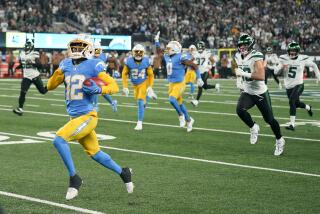The NFL : Passers Prefer Safety of Pocket
- Share via
A battered fraternity of NFL quarterbacks is retreating to the safety of the pocket.
After decades of chasing down scramblers, panting defensive linemen are locking their chinstraps and zeroing in on that theoretical cushion of safety three to five steps behind center. Today’s pro passers are bigger, stronger and less likely to stray than their predecessors; with the possible exception of Philadelphia’s Randall Cunningham, there doesn’t appear to be a worthy NFL successor to the Fran Tarkentons and Jim Zorns, players who never met a scramble they didn’t like.
“To be an effective quarterback at this level, the No. 1 thing you have to do is be able to pass from the pocket,” says Tampa Bay’s Steve DeBerg, who has never rushed for more than 59 yards in any of his 10 NFL seasons. “Making something happen by moving around is a bonus. I don’t think the typical NFL quarterback has ever gotten away much from being a pocket passer. For all their mobility, guys like Tarkenton and (Roger) Staubach were pocket passers, in a sense. Basically, throughout the league right now, you have quarterbacks who prefer to drop back and throw from the pocket. If you can’t do that, you won’t play in the NFL.”
DeBerg and Tarkenton represent opposite ends of the quarterback spectrum. Tarkenton had an extraordinary sense for where the pass rush was coming from and was blessed with the dexterity to avoid the drive-killing sack. Passers like DeBerg, Washington’s Jay Schroeder and Phil Simms of the NFL champion Giants prefer to take the sack rather than risk life, limb and interception. Unlike the linemen who protected Zorn and Tarkenton, their blockers know exactly where to form the pocket.
Cunningham, who gained 540 yards on the ground, is the only NFL quarterback to rush for more than 300 yards in 1986. Atlanta David Archer, Denver’s John Elway, Scott Pelleur of Dallas, Buffalo’s Jim Kelly and Boomer Esiason of Cincinnati can all nimbly avoid pressure, but they will run merely as a final option.
“With the rules set up the way they are, defensively you have to blitz,” says Cincinnati Coach Sam Wyche. “That’s simple and obvious. That also means you have to have a quarterback that can move. We’re not building an offensive system here around a pocket passer, we want our quarterback to do a little bit of everything. I will say that I think you have to be comfortable in the pocket to make it in this league. That’s where a Doug Flutie has a problem.”
In Cincinnati’s exhibition opener at Tampa Stadium, Wyche observed a quarterback that did a little bit of everything. Vinny Testaverde, the No. 1 pick in the draft after winning the Heisman Trophy at Miami (Fla.), consistently bought himself extra time with his mobility and fired three fourth-quarter touchdown passes in Tampa Bay’s 31-30 loss.
“Today’s quarterbacks are coming out of college 6-foot-4, 6-5, weighing 210, 220,” says Duke Coach Steve Spurrier, a former Heisman Trophy winning quarterback at the University of Florida. “I still like the mobile guy. A quarterback who can move effectively can eliminate mistakes and a lot of bad plays that spring from just sitting back there.”
One passer who rarely ventures from the pocket is Miami All-Pro Dan Marino, who uses football’s quickest release to avoid excessive sacks. Jim Everett, the young quarterback who enjoyed mixed success with the Los Angeles Rams last year, can also be found throwing deep downfield from football’s artificial bomb shelter. The day of the mad scrambler has apparently passed, eclipsed by a new breed of NFL quarterback who fits snugly into the pocket.
“That Testaverde is a lot of fun to watch,” says Bengal receiver Cris Collinsworth. “That cat’s a player -- he stands back there like Gibraltar.”
More to Read
Go beyond the scoreboard
Get the latest on L.A.'s teams in the daily Sports Report newsletter.
You may occasionally receive promotional content from the Los Angeles Times.










